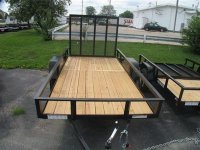I'd say it's OK under "normal" conditions. But rough roads, dips or humps in the road, etc. can give you a problem. I think the manufacturers usually leave themselve a little cushion; i.e., build them to handle a little more than they're rated for, but I wouldn't want to go much, if any, over their rating.
In my previous job i calculated with a safety factor of two: The trailer frame could handle twice the rated load, before permanent deformation (sagging) would occur.
An engineering rule of thumb is that you need a factor 1.5 to stay ahead of fatigue cracking over time, with a single direction static load (The load on a trailer is applied only by gravity, which works in one direction)
The other 0.5 of the safety factor, is 33% over the 1.5 which is needed to take care of fatigue. This 33% is to have a reserve for overloading, as well as a safety margin to take the bumps on rough roads (dynamic loads), cornering, uneven load of the frame.
For cargo pallet trailers, the safety margin could be reduced to a factor 1.8 because it allways rides with an even spread load. An equipment trailer, we sometimes took 2.2 to have more reserve when a heavy piece of equipment is loaded unfavourably, between the axles and kingpin so the bending force on the frame would be higher than when the load was spread evenly (like dirt) over the entire frame length.
In our size class, we used to build one of the tougher trailers on the (Dutch) market. Heavy haulage guys will probably work with even higher safety margins, but they dont have to struggle to get a certain payload within a given GCVW limit(they have an oversize, overweight permit anyways)
If you buy a lesser duty trailer at the same GVW, you have the brakes and axles to safely carry it, but you will crack or sag the frame over time if used very frequently, where the heavy duty trailer at the same rating will have a beefier frame which can take the load over time.
